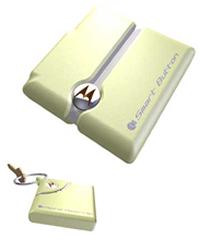Motorola Prototype - The SmartButton
20 August 2004 by axxxr SmartButton,a sleek-looking badge worn by the user which uses Bluetooth to connect to the user's mobile phone. Mobile phones get smaller and lighter every year. With the part count for the average mobile going down by 20-30% every year, a phone bought five years ago now looks as old-fashioned as a 1950s wireless. But will mobile phones eventually be so small that they do not even look like mobile phones? Clues can be found in Asia, where many of the world's most technologically advanced firms are based. Japanese and Korean customers have been unusually receptive to technological innovations. Consequently, firms use the Asian market as a test bed for new ideas. Mobile manufacturers have spotted the logical outcome of the ever-shrinking phone - a unit that can be worn rather than carried. A wearable phone is easier to use, and less likely to be lost or stolen. In Japan, says Michael King, a principal analyst with Gartner, manufacturers are beginning to produce "feminine-focused" phones using materials such as diamond and ruby bezels. Last year, two firms tried to cash in by launching wristwatch models. NTT DoCoMo's Wristomo phone, manufactured by Seiko and offering email and web browser functionality, sold out its initial run of 1,000 within 10 minutes of going on sale. Samsung's equivalent, touted as the world's first "Dick Tracy phone", launched last year offering GPRS, one and a half hours of continuous talk time, voice-activated dialling and a built-in phone book. It supported Wap and Bluetooth, and weighed less than 80 grams. But it seems unlikely that wristwatch phones will be hitting the UK any time soon - NTT DoCoMo stopped making the Wristomo after interest tailed off, and last year's promised European launch of Samsung's phone never happened. The problem manufacturers face is the tension between people's desire for smaller phones and their hunger for greater functionality. A phone with a camera, PDA functionality and web access is never going to be small enough to wear. In Japan, says King, there has even been a reversal of the trend for miniaturisation, with consumers preferrring bigger phones with larger screens and multiple LCDs. He argues that no solution will satisfy everyone. The answer could lie in Bluetooth, which allows short-range wireless communication. It enables a phone to have multiple functions without requiring them to be on the same physical device - and this is exactly the area Motorola is now working in. The firm has developed a prototype called the SmartButton, a sleek-looking badge worn by the user which uses Bluetooth to connect to the user's mobile phone. To use the phone, you don't need to pick up it up or even look at it, explains Joe Dvorak, a member of Motorola's technical staff: "If the user taps the SmartButton and says 'Call John Smith,' the phone looks up the number and places the call." Don't expect to be able to buy such phones in the next year or so, however. The technology is there, but firms are still trying to find the form that works. "It's just a matter of someone hitting on the right combination of Bluetooth connective accessories and miniaturised product," says King.
Via:blueserker.com guardian.co.uk
|











 RSS feed
RSS feed